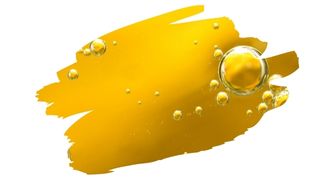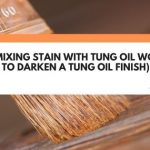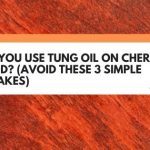Wood finishing is a mystical art form that only few of us can ever truly master…
…OK, so maybe that’s over-egging things a bit. 🙂
Let’s just say that applying some oil-based wood finishes can sometimes be a bit tricky. Least of all when that oil finish is a notoriously slow-drying one, such as Tung oil.
So, in this post, we dive into why you should not try to force pure Tung oil to dry too quickly. We also explain what ‘tipping off the finish’ means — and how you can use it to get a smooth finish.
And keep reading to discover how many coats of Tung oil you should be applying.

This post may contain affiliate links to products that we receive a commission for (at no additional cost to you). Learn more here.
Why Is My Pure Tung Oil Finish Bubbling?
Trapped air bubbles are usually due to Tung oil being forced to dry too quickly.
You see, Tung oil hardens as a result of a chemical reaction called polymerization. And as Tung oil polymerizes — and cures into a hard substance — this exothermic chemical reaction releases a bit of heat.
That heat warms up anything nearby. And that includes vaporizing some of the moisture contained in any wood fibers Tung oil happens to be coating.
Now usually, this isn’t a problem. Pure Tung oil dries so slowly that vapor has time to escape this finish — well before it cures and hardens.
But in some cases, if Tung oil dries too quickly, those bubbles won’t be able to escape. And when that happens, they become trapped in that finish.
This is why, in order to slow down the drying process of some oil-based wood finishes, we add slow-speed thinners.
However, in the case of pure Tung oil, this finish takes days to dry — and weeks to cure. So, unless you start blasting heat at it, those bubbles should naturally pop on their own given time.
Related Post: Tung Oil Not Drying? (3 Simple Ways To Fix It)
Could There Be Another Reason For Bubbling?
Absolutely. A range of issues can create the bubbling effect. For example, improper brush preparation can add air bubbles to a finish.
Also, applying Tung oil too thickly can cause bubbles to become trapped in that finish too.
Related Post: Walnut Oil Vs Tung Oil (They’re More Alike Than You Think)
So How Do You Get The Smoothest Finish On Wood?
Simply follow best practice when it comes to wood finishing:
1). Always Apply Thin Coats
Do not apply this oil finish too thickly. And always wipe away any excess after applying each coat.
Also, do not apply more than 3-4 coats per application. Even though it can be tempting to load up wood with numerous coats of Tung oil.
Nevertheless, if you apply too many coats, you’ll only hinder Tung oils ability to dry and/or cure.
Instead, stick to around 3-4 coats. And then give it 4 weeks to dry and cure. Afterward, you can return and apply another round of 3-4 more coats over the previous application.
2). Rinse The Brush Before You Apply
To avoid adding bubbles to the finish, use a synthetic bristle brush.
And make sure you prepare the brush by dipping it in solvents first, squeezing off the excess. After that, you can go ahead and dip it into the can.
3). Don’t Wait Too Long To Wipe Off The Excess
After you coat on Tung oil, you need to give it time to really sink down into wood.
But give it no more than 15-30 minutes to really soak in, and then start wiping.
How Long Should Tung Oil Sit Before Wiping? No less than 10 minutes, but ideally around 15 to 30 minutes.
But How Do You Get Bubbles Out Of Tung Oil After You’ve Applied It?
By using a technique called ‘tipping off the finish’.
This involves using your bristle brush, to press out those bubbles, by sweeping the brush across the finish.
Simply make sure you do the following two things before you start:
1). Use A Clean Bristle Brush
Your brush should be clean of any Tung oil. You are not looking to add more oil to wood.
Related Post: Do You Really Need To Raise The Grain Before Applying Oil?
2). Keep It Light
This technique requires a light touch. Move your brush with the grain, applying next-to-no downward pressure.
The bristles of that brush should not bend as you move it across the surface. If they do, then you’re pressing a touch too hard.
How Many Coats Of Tung Oil Should Be Used? Around 3-4 coats per application is best. Unless the wood you’re applying it onto is very porous. In which case, you may add an additional 1-2 more coats at most. Any more than that, and that Tung oil finish will become too thick to dry evenly.
To Wrap Up, Here Are The 3 Key Takeaways From This Post…
- 1). Pure Tung oil is a very slow drying wood finish. It can take days to dry, and up to a month to cure and harden.
- 2). If you force Tung oil to dry/cure too quickly, air bubbles may become trapped inside this finish.
- 3). If there are bubbles trapped in still-wet Tung oil, you can ‘tip off’ the finish. This involves popping those bubbles using a bristle brush.
References:
Arminger, Benjamin, et al. “On the drying behavior of natural oils used for solid wood finishing.” Progress in Organic Coatings 148 (2020): 105831.
Wexler, Herman. “Polymerization of drying oils.” Chemical Reviews 64.6 (1964): 591-611.



